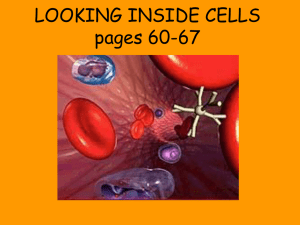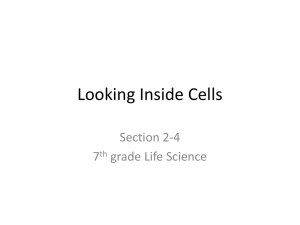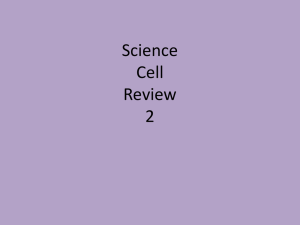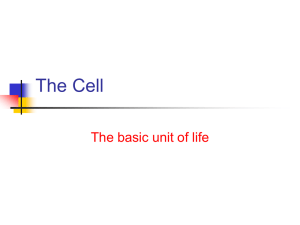Cell membranes are found in animal cells whereas cell walls are
advertisement
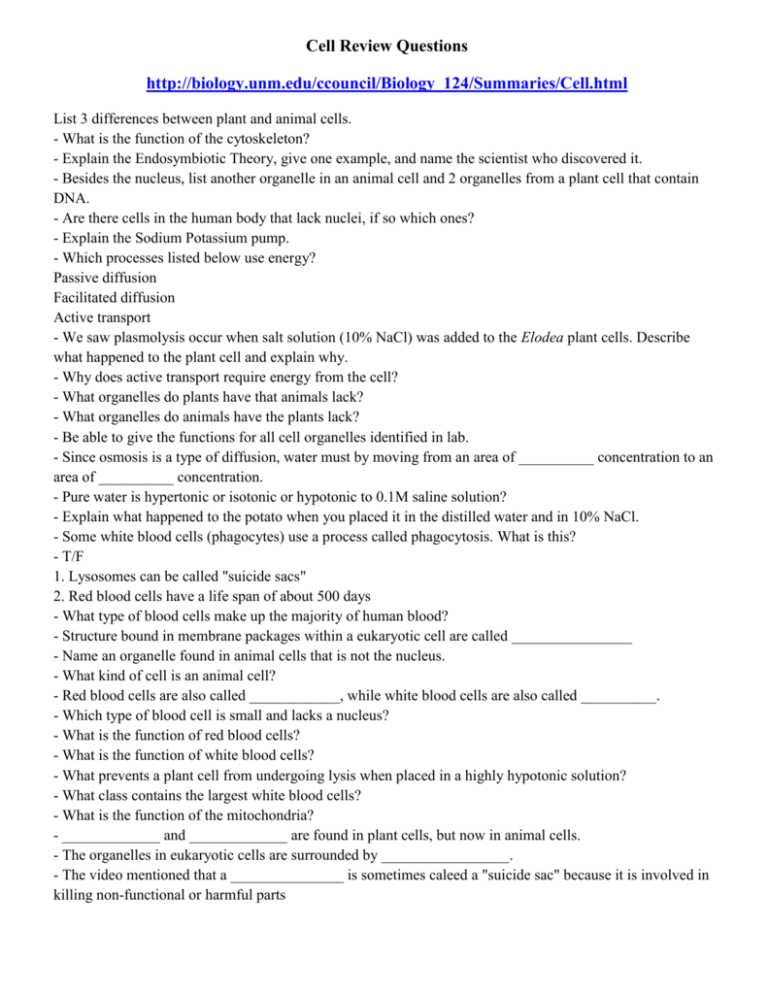
Cell Review Questions http://biology.unm.edu/ccouncil/Biology_124/Summaries/Cell.html List 3 differences between plant and animal cells. - What is the function of the cytoskeleton? - Explain the Endosymbiotic Theory, give one example, and name the scientist who discovered it. - Besides the nucleus, list another organelle in an animal cell and 2 organelles from a plant cell that contain DNA. - Are there cells in the human body that lack nuclei, if so which ones? - Explain the Sodium Potassium pump. - Which processes listed below use energy? Passive diffusion Facilitated diffusion Active transport - We saw plasmolysis occur when salt solution (10% NaCl) was added to the Elodea plant cells. Describe what happened to the plant cell and explain why. - Why does active transport require energy from the cell? - What organelles do plants have that animals lack? - What organelles do animals have the plants lack? - Be able to give the functions for all cell organelles identified in lab. - Since osmosis is a type of diffusion, water must by moving from an area of __________ concentration to an area of __________ concentration. - Pure water is hypertonic or isotonic or hypotonic to 0.1M saline solution? - Explain what happened to the potato when you placed it in the distilled water and in 10% NaCl. - Some white blood cells (phagocytes) use a process called phagocytosis. What is this? - T/F 1. Lysosomes can be called "suicide sacs" 2. Red blood cells have a life span of about 500 days - What type of blood cells make up the majority of human blood? - Structure bound in membrane packages within a eukaryotic cell are called ________________ - Name an organelle found in animal cells that is not the nucleus. - What kind of cell is an animal cell? - Red blood cells are also called ____________, while white blood cells are also called __________. - Which type of blood cell is small and lacks a nucleus? - What is the function of red blood cells? - What is the function of white blood cells? - What prevents a plant cell from undergoing lysis when placed in a highly hypotonic solution? - What class contains the largest white blood cells? - What is the function of the mitochondria? - _____________ and _____________ are found in plant cells, but now in animal cells. - The organelles in eukaryotic cells are surrounded by _________________. - The video mentioned that a _______________ is sometimes caleed a "suicide sac" because it is involved in killing non-functional or harmful parts Organelles and Their Functions In this lab you will look at the eukaryotic cells of plants and animals. Eukaryotic cells are distinguished from the more primitive prokaryotic cells by the presence of 1) cytoplasmic membranous organelles, 2) a nuclear membrane (i.e. a true nucleus), and 3) chromosomal proteins. In this lab we will focus primarily on organelles, their functions within the cell and how they differ between plant and animal cells. Think of the cell as a microscopic city. Like a real city it requires many services to keep it clean and running smoothly. Think of some of the services a real city needs: traffic control, waste disposal, and authority figure just to name a few. Like our imagined city a cell needs the same services. Organelles are the “workers” that provide these services. The following is a list describing the various functions of some common organelles. The NUCLEUS (“mayor of city hall”) The nucleus houses the majority of genetic material of a cell. The nucleus is the “brain” of the cell and controls all activity within the cell. Using DNA as a blueprint (like the blueprints of a city) the nucleus directs the production of proteins. You will learn about this process in the DNA Transcription and Translation lab. A nucleus with the DNA coiled into chromatin. Electron microscope picture of a nucleus RIBOSOMES (“lumber or brick yard”) The ribosomes carry out manual labor in the form of protein synthesis for the nucleus. They bring together all the raw ingredients such as RNA (copies of the original DNA blueprints) and amino acids to assemble proteins. The proteins created are essential to cell and organismal function. Think of proteins as machinery for cell functions much like electricity and plumbing are essential in a real city. For example, enzymes are a type of protein without which life could not exist. The large and small subunits of ribosomal RNA translating an mRNA strand into a polypeptide chain. Refer to DNA Transcription and Translation for further reading. The ENDOPLASMIC RETICULUM (“highways and road systems”) There are two types of endoplasmic reticulum (ER) – Smooth ER and Rough ER. This extensive network makes up approximately one half of all membranous tissue of the cell and is the site of membrane and protein synthesis. The ER system is much like a road system along which industry can be found. Goods are manufactured and shipped to needed areas via the road system. Rough ER is named for the presence of ribosomes along its membrane and is the source of proteins. Smooth ER lacks ribosomes and is responsible for lipid synthesis and processes a variety of metabolic processes such as drug detoxification. Can you tell the difference between the smooth and rough ER? CELL MEMBRANE (“City Border”) and CELL WALL (“City Wall”) Cell membranes are found in animal cells whereas cell walls are found in plant cells. Cell walls and membranes have similar functions. Like a city perimeter, cell membranes surround the cell and have the ability to regulate entrance and exit of substances, thereby maintaining internal balance. These membranes also protect the inner cell from outside forces. Cell walls, as the city analogy implies, are much stronger than cell membranes and protect cells from lysing (exploding) in extremely hypotonic (diluted) solutions. You will learn more about these concepts in the Biological Membranes lab. Artist rendition of an animal cell membrane. Artist rendition of a plant cell wall. CYTOSKELETON (“steel girders”) The cytoskeleton makes up the internal framework, like the steel girders that are the framework for buildings in a city that gives each cell its distinctive shape and high level of organization. It is important for cell movement and cell division (mitosis). Picture of a cell’s cytoskeleton- a complex network of tubules and filaments. CYTOPLASM (“lawns and parks”) Cytoplasm is a semi-fluid substance (think gelatin) found inside the cell. The cytoplasm encases, cushions and protects the internal organelles. It is the cell landscape found in any space where organelles are not and therefore is much like the lawns and parks of our city. The cytoplasm is the substance surrounding the visible vacuoles in this cell. GOLGI APPARATUS (“post office”) Like a post office, the golgi apparatus is used for shipping those goods created by the ER and ribosomes to the rest of cell. EM picture of a golgi apparatus Artist rendition of the Golgi Complex CHLOROPLASTS (“solar energy plant”) Chloroplasts are organelles found only in plant cells. Like a solar energy plant they use sunlight to create energy for the city. Chloroplasts are the site of photosynthesis a process in which the plant uses carbon dioxide, water and sunlight to create energy in the form of glucose for the plant cell as well as heterotrophs that consume the plant. Artist rendition of a chloroplast- site of photosynthesis in plant cells. MITOCHONDRIA (“energy plant”) Mitochondria are found in both plant and animal cells and is the site of cellular respiration. Through this process that will be covered in the Photosynthesis and Respiration lab ATP is created which is used for energy by the cell. Electron microscope picture of a mitochondria. LYSOSOMES (“waste disposal and recycling”) The lysosomes are digestive sacs that can break down macromolecules in the cell using the process of hydrolysis. The digestion is carried out with lysosomal enzymes found in the lysosome. Like waste disposal in a city, lysosomes help keep excessive or bulky macromolecules from building up in the cell. Electron microscope picture of a lysosome. VACUOLES and VESICLES (“warehouses, water towers or garbage dumps”) Think of these membrane sacs that have a variety of functions as containment units for anything in excess in a city. They can hold many substances from organic molecules to simple excess water. Plant cells have a central vacuole that is important in maintaining plant turgidity. You can read more about this phenomenon in the Biological Membranes Lab. Central vacuole of a plant cell. Plant versus Animal Cells Now that you know some important cell organelles let us identify those that distinguish plant cells from animal cells. From the descriptions above, we can identify three organelles unique to plant cells: 1) cell wall (versus a cell membrane in animal cells), 2) central vacuole (regular vacuoles are found in animal cells) and 3) chloroplasts (animals do not perform photosynthesis. This is what makes plants autotrophs and animals heterotrophs.) Bacterial Cell Review Plant Cell Review Animal Cell Review .



